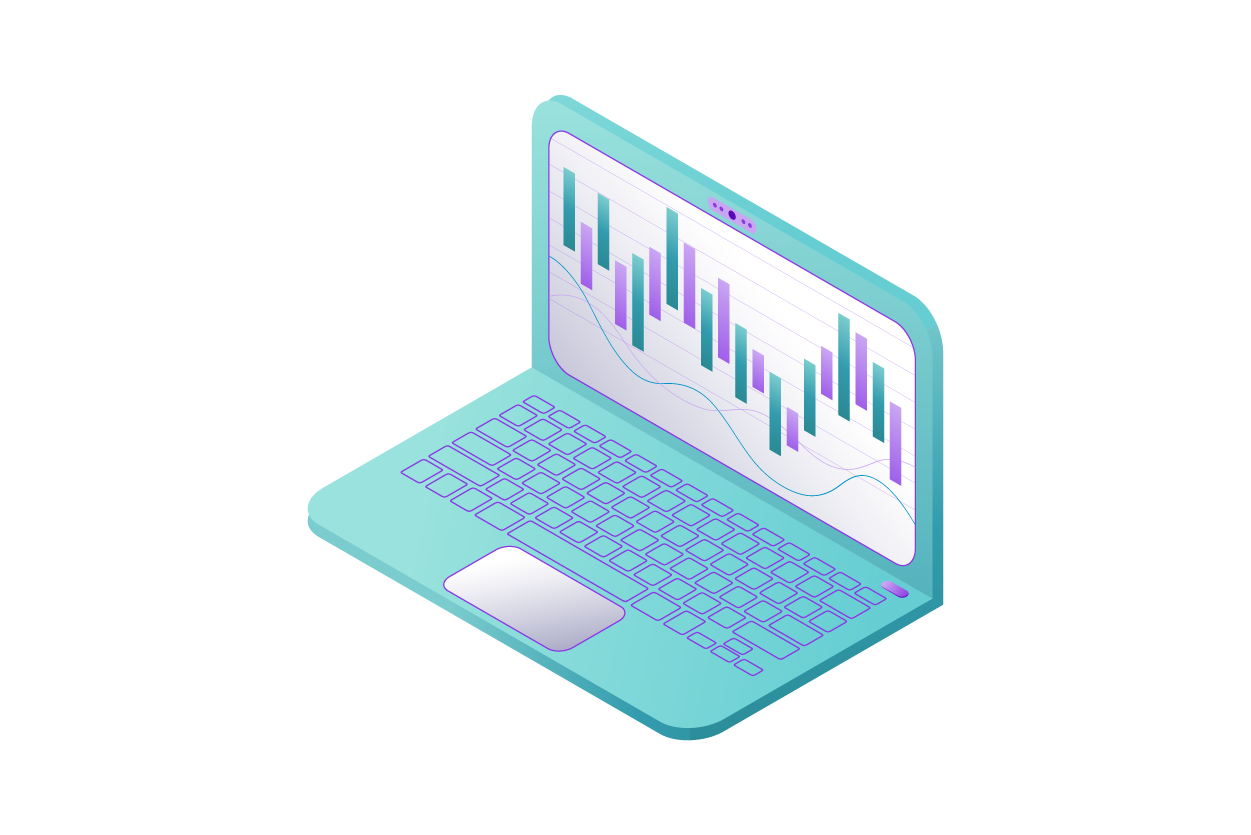
The process of foreign exchange trading is complicated but may be very rewarding, attracting those who want to get acquainted with it in detail. Forex markets trade in currencies at their core. In order to thrive in this area, there is a need to comprehend and utilize forex trends and tendencies as important signs of market movements.
Trends refer to the general direction of the price movement in the forex market within a certain time frame. The forex trends could be in the form of uptrends, downtrends, or sideways trends. An uptrend means that the price of a currency pair is escalating gradually, while a downtrend implies a falling value of the same currency pair. The second kind of trend is a sideways one where the rate remains quite constant and changes slightly.
For the reason that this is a thorough article, in this discussion we will focus deeply on the fascinating world of Forex trends, revealing what they mean, how to identify them, and the approaches to dealing with those trends.
What Are Forex Trends?

Numerous currency pairings exist and change dynamically, hence the notion of forex trends. These trends serve to navigate them across unexplored markets filled with promising profits waiting to be discovered. They are the heartbeat of the forex trends market, representing sentiments, economic factors, and news.
1. Uptrend – Riding the Optimistic Wave
Spring is optimistic. For the forex trend market, an uptrend is like a blossoming garden. This occurs whenever there is a rise in the value of some currency pairs, suggesting positivity and optimism for other traders. Traders look into these buoyant conditions and try to purchase long positions, hoping that the trend will continue to move up.
These can arise after favorable economic data, profit reports with good numbers, or a general optimistic outlook by traders. These are similar to when a powerful headwind pushes on a sailboat, moving it upwards. Competent traders will be able to discern bull trends against a host of background noise and capitalize upon the general optimism for rising values in the currency pair.
2. Downtrend – Navigating the Stormy Seas
On the other hand, a downtrend will paint a different story on the canvas of forex trends. This can be described as a bearish market feeling, implying that the price of a currency pair declines. When in a downtrend, traders start looking for opportunities to sell or assume a short position.
This approach is based on the presumption that the phenomenon will spread further. Negative economic developments, political issues,and an excess of market pessimism set downtrends in motion. Just like these gathering dark clouds on the horizon, these elements shadow currency values. This, however, is beneficial to smart traders as they identify when to make a sell order, just like an experienced captain maneuvers his boat through dangerous waters without hitting shoals.
Also Read: Market Maker Options: Definition and How They Make Money
3. Sideways or Range-bound – A Trader’s Quandary
Another type of trend that is usually tough for traders is a sidetrend, also called a range bound trend. In this circumstance, a currency pair trades in a rather limited price movement direction that does not show any upward or downward tendency. However, it shifts sideways and looks like the route of a river in a flatland. For trading range-bound markets, it is a matter of different skills and strategies. In this case, traders tend to look for chances to make profits out of the price volatility associated with the existing range.
Range trading is a buying approach that involves purchasing close to the identified support levels, followed by selling at the resistance zones. It will seek to earn an income from price fluctuations while the market stays within a certain range. Markets have a tendency to become range bound when there is an intricate balance between trader’s purchase and sell pressures, and traders resort to using oscillators as well as other technical tools for recognizing oversold and overbought condition to ascertain where better entry and exit positions are
How to Identify Forex Trends?

Interpreting forex trends precisely is the essence of determining a trader’s success in making sound and eventually profitable transactions within the enormously expansive and dynamic terrain of forex trends trading. The traders strive to attain such sophistication in trading with a wide range of sophisticated technical analysis tools and indicators that give different perspectives on market behavior and price dynamics. Let’s embark on a comprehensive exploration of these methods used to identify and understand forex trends, delving deeper into their mechanics and significance:
1. Moving Averages – The Flowing River of Market Sentiment
Technical analysis, much like a river that runs through its surroundings, is an immutable aspect of moving averages. As such, these moving averages provide a smoothing impact on the erratic and fluctuating price data to generate a steady-flowing line on pricing charts. Short-term moving averages with regard to long-term ones act as strong guiding instruments for forex trend traders. When a short-term simple moving average smoothly passes through a long-term, this is usually viewed as a favorable indication of a trend or like a guiding light, signifying a tendency that is upwards.
The crossing by the averages represents a strong outlook for the currency pair as their price increase is imminent. On the other hand, if the short-term moving average smoothly traverses above the long-term moving average, it causes vibrations in the market that indicate that investors are now bearish. Such a crossing symbolizes an early trend and positions traders on the opposite side averagely. Market sentiment is represented by these moving averages on a dynamic basis, depicting the current trend and its sustainability.
2. Relative Strength Index (RSI) – Gauging the Pulse of Market Momentum
In the FX market, RSI serves as an equivalent of the pulse monitor, which measures the heartbeat’s strength for price change. Traders use this priceless gadget to estimate the rate at which prices vary as well as the amount of change involved. RSI is key in forex trends analysis by providing information on market conditions. The RSI signal is an alert when the RSI needle rises above 70 and indicates that the currency pair is probably getting overbought (similar to having a sudden fast pulse rate).
It also indicates that this could mean a probable flip soon. On the other hand, after the needle falls under thirty, an oversold condition is indicated, and just like patients with low body temperature, it is imperative for traders for this to be regarded as an essential signal. This can signal a turning point in the opposite direction. A comprehensive analysis of a trend can be done by slicing RSI data along with prices for a health checkup of the trend, the strength it possesses, and how healthy it is for a trade.
3. Trendlines – Sketching the Path of Market Direction
Just as an artist draws the contours of a landscape, so do we draw trendlines on our price charts because they show the general direction of the markets. To form trend lines in an uptrend, traders use downward sloping lines that connect the bottoms of the respective price charts. The trendlines show the upward moving prices that represent the positive expectation in the economy.
On the other hand, at the top of the downtrend chart, traders plot a sloping trendline that connects the points at which high prices were reached. These downtrends show how currencies are falling, reflecting the notion behind bearish sentiment. In reality, trendlines are as much artwork in the world of forex trend trading as brushes are in a painter’s work on a canvas. Further, these trendlines are integral to forecasting possible trend breaks once they are broken, just like detecting changes in course when traversing a new forest.
4. Support and Resistance Levels – The Pillars of Trend Assessment
Support as well as resistance levels form the basis on which traders base their analysis of movements in the forex market. The same way as the cornerstones for a huge building, they constitute significant elements for analysis of the market’s behavior. The buying interest of a currency is encountered at support levels. Just like a sturdy fortress wall that keeps attackers away, these are the levels that thwart additional price drops from taking place in the market.
They represent the areas where the currency pair could stop falling lower. At the point of contact, however, it is often selling pressure originating at resistance that stops the currency pair from rising any further. Hence, these levels act like a glass ceiling that restricts progression. Identifying these tiers helps traders comprehend the limits and width of a trend. A breakup above resistance or below the support level is like an earthquake, which could be a sign of changing direction. Break-outs serve in several crucial areas, such as assisting the traders to navigate through a sea full of forex trends and tides.
Strategies to Navigate Forex Trends

Identification of forex trends is only the first important phase. You then have to create an approach that allows you, as an investor, to make the most profits by buying and selling skillfully. Here, we will explore various trading approaches to consider, depending on the nature of the identified trend:
– Trend Following
Its popularity lies in its use by many traders who attempt to exploit the momentum that arises from a directional trend. Trend following, in fact, is trading the way of a moving trend. Long position traders are looking upward while hoping that the trend will continue on an uptrend.
On the other hand, during a downtrend, traders are interested in selling or going short and benefit from declining prices. Success in trend following is usually achieved when one can pinpoint the right entries and exits based on the trend’s motion, which are sometimes boosted by moving average or trend line analysis.
– Counter-Trend Trading
This is called counter-trend trading, and it is centered around spotting possible reversals in the market. This strategy involves traders searching for indications that the current trend, near the exhaustion point, is ready for a reversal.
These can include evidence of overbought and oversold conditions, divergences in some indicators, and candlestick patterns that may indicate the start of another trend. In this regard, and seeking to take advantage of the momentum markets are known to exhibit from time to time and make huge profits, counter-trend traders enter trades opposite the trend.
Also Read: Market Making: Strategies and Techniques
– Range Trading
In case the market becomes involved in a sideways or range-bound trend, range trading comes as an alternative method. In this case, traders acquire near marked support points while at the same time selling close to the stated resistance regions in the predefined range.
Range trading aims at taking advantage of these fluctuations in prices in this limited range. Technical indicators, especially oscillators, are the most common tools that range traders rely on to ascertain the conditions of overbought or oversold stocks so they can purchase or sell a stock while it is in a price range corridor.
– Risk Management
A good risk management strategy does not matter what kind of trend we are following or which trading strategy will be applied. The steps involve putting in place stop loss orders to mitigate possible losses and adjusting the size of positions based on one’s risk bearing capacity. As a trader, it is important to manage risks effectively because there is no shortage of surprises in the forex trend market that can lead to losses, thus losing out on trade capital.
Conclusion
To wrap up, knowledge of how to read and trade forex trends goes a long way toward securing success in trading. There are two things that one must consider when it comes to forex trend trading, whether one is a novice or an expert — being able to identify forex trends and using suitable approaches.
It is essential that new entrants build a good knowledge base, starting with basic principles. This means that one should understand basic forex trend concepts like currency pairs, pips, and leverage. Be keen on the different types of trends, including uptrends, downtrends, and sideways trends, because they constitute the basis of your trading decisions. One needs to educate themselves by reading several books or doing some research on reliable forex trend forums.
In addition, one should be aware of international economic updates and how they influence foreign currency markets. That is basically an element of such an analysis. Knowledge about the driving forces behind currency movements like interest rates, economics, data, and geopolitics helps to widen the understanding, which in turn aids in better decision making on the trades made. Note, however, that other traders use both techniques to obtain an overall perspective of the markets.
Disclaimer: The information provided by Quant Matter in this article is intended for general informational purposes and does not reflect the company’s opinion. It is not intended as investment advice or a recommendation. Readers are strongly advised to conduct their own thorough research and consult with a qualified financial advisor before making any financial decisions.

I craft stories that make complex ideas clear. I simplify the blend of data science, machine learning, and crypto trading, showcasing how advanced tech and quantitative models analyze data for informed trading choices. Join me in exploring the realm of quantitative trading, where my narratives make intricate concepts easy to grasp.
- Alifia Berizkyhttps://quantmatter.com/author/alifia-berizky/
- Alifia Berizkyhttps://quantmatter.com/author/alifia-berizky/
- Alifia Berizkyhttps://quantmatter.com/author/alifia-berizky/
- Alifia Berizkyhttps://quantmatter.com/author/alifia-berizky/
